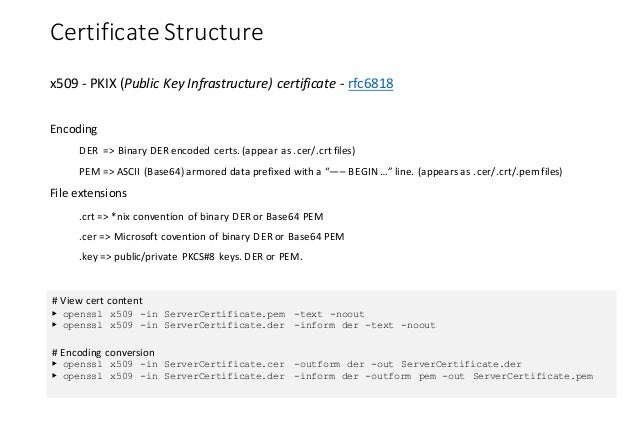Openssl Generate Public Key Der
- Openssl Rsa Public Key
- Generate Rsa Key Openssl
- Openssl Generate Public Private Key
- Openssl Read Key
- Openssl Create Private Key
While Encrypting a File with a Password from the Command Line using OpenSSLis very useful in its own right, the real power of the OpenSSL library is itsability to support the use of public key cryptograph for encrypting orvalidating data in an unattended manner (where the password is not required toencrypt) is done with public keys.
$ openssl pkey -in private-key.pem -out public-key.pem -pubout You may once again view the key details, using a slightly different command this time. $ openssl pkey -in public-key.pem -pubin -text The output for the public key will be shorter, as it carries much less information, and it will look something like this.
The Commands to Run
Generate a 2048 bit RSA Key
- A PEM file is simply a DER file that's been Base64 encoded. To convert from one to the other you can use openssl with the -inform and -outform arguments. Each one takes one of PEM, DER or NET (a dated Netscape format, which you can ignore). You can change a key from one format to the other with the openssl rsa command (assuming it's an RSA key.
- OpenSSH public key format is different from PEM format. You have to run ssh-keygen to convert it. Ssh-keygen -f /.ssh/idrsa.pub -e -m PEM pubkey.pem Then convert it to DER format using openssl rsa.
- Openssl req -out CSR.csr -new -newkey rsa:2048 -nodes -keyout privateKey.key will include your public key. This is mandatory as per the PKI process. The CSR, containing your entity information and the public key is sent to any Certificate Authority you like for a request of certificate (hence the CSR name).
- Openssl x509 -in cert.crt -outform der -out cert.der DER to PEM openssl x509 -in cert.crt -inform der -outform pem -out cert.pem Combination. In some cases it is advantageous to combine multiple pieces of the X.509 infrastructure into a single file. One common example would be to combine both the private key and public key into the same.
- This section provides a tutorial example on how to generate certificates in DER and PEM formats using 'OpenSSL'. After tested how 'keytool' can be used to export certificates in DER and PEM formats, I decided to try with 'OpenSSL' to see if it can generate certificates in DER and PEM formats or not.
You can generate a public and private RSA key pair like this:
openssl genrsa -des3 -out private.pem 2048
/command-and-conquer-generals-2-beta-key-generator-download.html. That generates a 2048-bit RSA key pair, encrypts them with a password you provideand writes them to a file. You need to next extract the public key file. You willuse this, for instance, on your web server to encrypt content so that it canonly be read with the private key.
Export the RSA Public Key to a File
This is a command that is

openssl rsa -in private.pem -outform PEM -pubout -out public.pem
The -pubout flag is really important. Be sure to include it.
Next open the public.pem and ensure that it starts with-----BEGIN PUBLIC KEY-----. This is how you know that this file is thepublic key of the pair and not a private key.
To check the file from the command line you can use the less command, like this:
less public.pem
Do Not Run This, it Exports the Private Key
A previous version of the post gave this example in error.
openssl rsa -in private.pem -out private_unencrypted.pem -outform PEM
The error is that the -pubout was dropped from the end of the command.That changes the meaning of the command from that of exporting the public keyto exporting the private key outside of its encrypted wrapper. Inspecting theoutput file, in this case private_unencrypted.pem clearly shows that the keyis a RSA private key as it starts with -----BEGIN RSA PRIVATE KEY-----.
Visually Inspect Your Key Files
It is important to visually inspect you private and public key files to makesure that they are what you expect. OpenSSL will clearly explain the nature ofthe key block with a -----BEGIN RSA PRIVATE KEY----- or -----BEGIN PUBLIC KEY-----.
You can use less to inspect each of your two files in turn:
less private.pemto verify that it starts with a-----BEGIN RSA PRIVATE KEY-----less public.pemto verify that it starts with a-----BEGIN PUBLIC KEY-----
/kaspersky-internet-security-2017-keys-generator-free-365-days.html. The next section shows a full example of what each key file should look like.
The Generated Key Files
The generated files are base64-encoded encryption keys in plain text format.If you select a password for your private key, its file will be encrypted withyour password. Be sure to remember this password or the key pair becomes useless.
The private.pem file looks something like this:
The public key, public.pem, file looks like:

Protecting Your Keys
Depending on the nature of the information you will protect, it’s important tokeep the private key backed up and secret. The public key can be distributedanywhere or embedded in your web application scripts, such as in your PHP,Ruby, or other scripts. Again, backup your keys!
Openssl Rsa Public Key
Remember, if the key goes away the data encrypted to it is gone. Keeping aprinted copy of the key material in a sealed envelope in a bank safety depositbox is a good way to protect important keys against loss due to fire or harddrive failure.
Oh, and one last thing.
If you, dear reader, were planning any funny business with the private key that I have just published here. Know that they were made especially for this series of blog posts. I do not use them for anything else.
Generate Rsa Key Openssl
Found an issue?
Openssl Generate Public Private Key
Rietta plans, develops, and maintains applications.
Openssl Read Key
Learn more about our services or drop us your email and we'll e-mail you back.